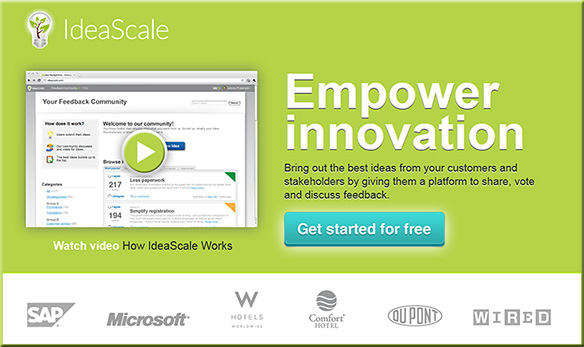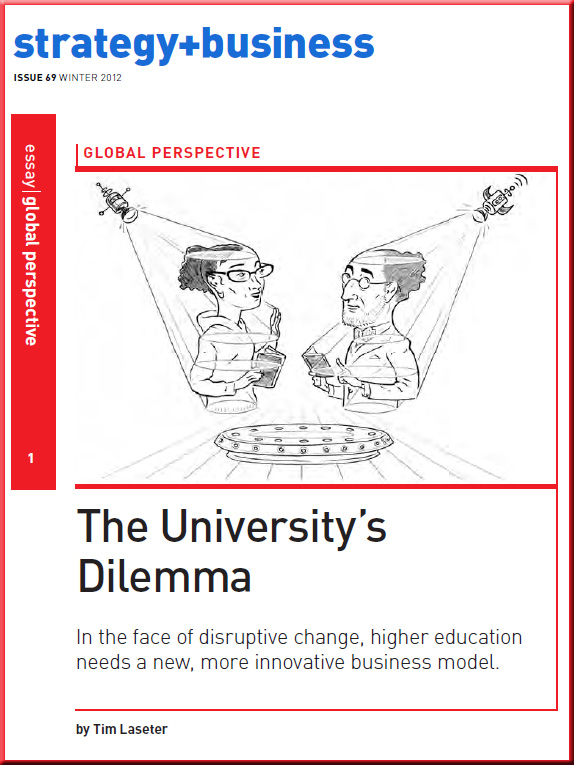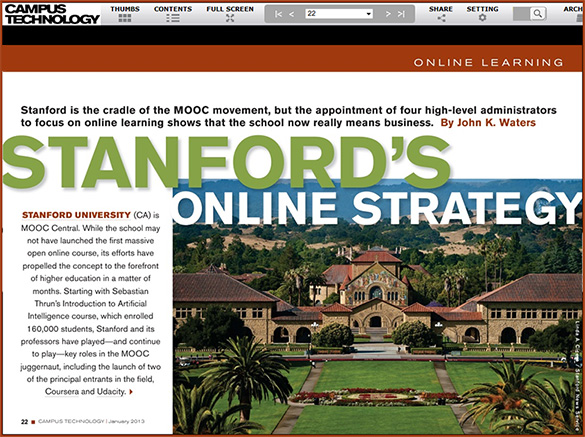Briefing on MOOCs for the Board of Governors — from Tony Bates




Briefing on MOOCs for the Board of Governors — from Tony Bates
From DSC:
Some very frustrated reflections after reading:
Excerpt:
Right now, boys are falling out of the kindergarten through 12th grade educational pipeline in ways that we can hardly imagine.
This situation continues to remind me of the oil spill in the Gulf (2010), where valuable resources spilled into the water untapped — later causing some serious issues:
.
From DSC:
What are we doing?!!! We’ve watched the dropout rates grow — it doesn’t seem we’ve changed our strategies nearly enough! But the point that gets lost in this is that we will all pay for these broken strategies — and for generations to come! It’s time to seriously move towards identifying and implementing some new goals.
What should the new goals look like? Here’s my take on at least a portion of a new vision for K-12 — and collegiate — education:
Crowdsourcing innovation on campus — from CampusTechnology.com by Dian Schaffhauser
By combining innovation management with crowdsourcing, Davenport University has found a potent formula for achieving continual improvement and encouraging organizational change.
.
ASTD TechKnowledge 2013 Conference Backchannel: Curated Resources — from David Kelly
Excerpt:
I am a huge proponent of backchannel learning. There are many conferences I would love to be able to attend, but my budget can only accommodate one or two each year. The backchannel is an excellent resource for learning from a conference or event that you are unable to attend in-person.
Also see David’s posting:
From DSC:
First, what prompted the questions and reflections that are listed below? For that, I turn to some recent items that I ran across involving the use of robotics and whether that may or may not be affecting employment:
The work of Erik Brynjolfsson and Andrew McAfee; for example their book Race Against the Machine
Excerpt of description:
But digital innovation has also changed how the economic pie is distributed, and here the news is not good for the median worker. As technology races ahead, it can leave many people behind. Workers whose skills have been mastered by computers have less to offer the job market, and see their wages and prospects shrink. Entrepreneurial business models, new organizational structures and different institutions are needed to ensure that the average worker is not left behind by cutting-edge machines.
How to freak out responsibly about the rise of the robots — from theatlantic.com by Derek Thompson
It’s fun to imagine an economy where machines are smarter than humans. But we don’t need an artificial crisis over artificial intelligence.
Excerpt:
Let’s say it upfront: Technology can replace jobs and (at least temporarily) increase income inequality. From the spinning jenny to those massive mechanical arms flying wildly around car assembly lines, technology raises productivity by helping workers accomplish more in less time (i.e.: put a power drill in a human hand) and by replacing workers altogether (i.e.: build a power-drilling bot).
…
What ails us today isn’t a surplus of robots, but a deficit of demand. Yes, we have a manufacturing industry undergoing a sensational, but job-killing, productivity revolution — very much like the one that took farm employment from 40 percent in 1900 to less than 5 percent today. But the other nine-tenths of the economy are basically going through an old-fashioned weak-but-steady recovery, the kind that hundreds of years of financial crises would predict.
America has hit “peak jobs” — from techcrunch.com by Jon Evans
Excerpt:
“The middle class is being hollowed out,” says James Altucher. “Economists are shifting their attention toward a […] crisis in the United States: the significant increase in income inequality,” reports the New York Times.
Think all those job losses over the last five years were just caused by the recession? No: “Most of the jobs will never return, and millions more are likely to vanish as well, say experts who study the labor market,” according to an AP report on how technology is killing middle-class jobs.
Technology and the employment challenge — from project-syndicate.org by Michael Spence
Excerpt:
MILAN – New technologies of various kinds, together with globalization, are powerfully affecting the range of employment options for individuals in advanced and developing countries alike – and at various levels of education. Technological innovations are not only reducing the number of routine jobs, but also causing changes in global supply chains and networks that result in the relocation of routine jobs – and, increasingly, non-routine jobs at multiple skill levels – in the tradable sector of many economies.
Man vs. robot — from macleans.ca by Peter Nowak
.
.
Secondly, some reflections (from DSC)
I wonder…
Again, for me, the answer lies at least partly in helping people consistently obtain the knowledge that they need — i.e. to help them build, grow, and maintain their own learning ecosystems — throughout their lifetimes. We need to help people dip their feet into the appropriate streams of content that are constantly flowing by.
Perhaps that’s one of the key new purposes that K-12, higher ed, and the corporate training departments out there will play in the future as they sift through the massive amounts of information coming at us to help individuals identify:
.
A seat at the table at last — from campustechnology.com by Andrew Barbour
One result of the Year of the MOOC is that IT is finally getting a say in the strategic direction of the institution.
Excerpt:
It’s interesting that it took an external force to propel IT into this inner circle. I can’t recall how many stories CT has run proposing strategies for how CIOs could win a place at the table. At the end of the day, though, changing an institution as hidebound as the average college is not easily tackled from within. In contrast, there’s nothing like a little existential angst to shake things up.
But MOOCs aren’t the only drivers of this change. We often think of BYOD as stripping IT of control but–on the broader stage–it may be playing its own part in elevating IT’s profile on campus. For years, faculty resisted IT recommendations on how technology could improve teaching and learning. Saying no was easy–preserving the status quo always is. That’s changing now. BYOD is a force that faculty can’t resist. It is, after all, their customers bringing the devices to school. Suddenly, faculty are faced with demands for new styles of teaching that accommodate student preferences for technology and much more. Enter IT and a host of others who see the potential of tech in education.
Also relevant/see:
Also see:
Excerpt:
Today Udacity is thrilled to announce a partnership with San Jose State University to pilot three courses — Entry-Level Mathematics, College Algebra, and Elementary Statistics — available online at an affordable tuition rate and for college credit. To my knowledge, this is the first time a MOOC has been offered for credit and purely online. Much credit for this partnership goes to Mo Qayoumi and Ellen Junn, president and provost of SJSU, and to the five fearless SJSU professors who have chosen to work with us at Udacity to explore this new medium. The offices of Governor Brown and CSU Chancellor White have also been critically important to this partnership for their leadership and expediency. Last but not least, I want to personally thank our great Udacians who, like everyone on this list, have worked endless hours to drive innovation.
Over the past year, MOOCs have received a lot of attention in the media and education circles mostly because so many students are taking advantage of the course for free. Predictions that MOOCs would fundamentally change higher education often revolved around the fact that the courses have unprecedented reach and affordability.
From DSC:
Given that such “Walmarts of Education” (i.e. solid learning at a greatly reduced prices) continue to develop, what’s our/your plans for responding to this trend? How are we/you going to compete? What’s our/your vision and strategy? By the way, you can look all you want to for data — but at the end of the day, it’s likely with this sort of thing that you won’t find all of the data that you require to make a decision. Examples:
Also from Campus Technology re: the elements in a collaborative classroom:
Just ahead: The robotics revolution — from kiplinger.com by Art Pine; with thanks going out to Erik Brynjolfsson (@erikbryn) for his posting on Twitter re: this
The U.S. is on the cusp of an explosion in robotics that will have a significant impact on business and the economy over the next decade. Here’s how it will affect you.
Excerpt:
The use of robotics in manufacturing and service industries is expected to mushroom over the next 10 to 15 years, forcing significant changes in the way many companies do business, and posing opportunities — and problems — for workers.
From DSC:
I don’t mean to be negative here…but…are we leaving a large swath of people behind? If many people don’t like learning — as evidenced by the dropout rates across the United States — the mountains will be much harder to climb in terms of helping people reinvent themselves as these events/trends take place. The ramifications are immense and affect all of us!
What SHOULD these things mean for K-12? Higher education? The corporate training departments?
From DSC:
The other day, I mentioned how important it will be for institutions of higher education to increase the priority of experimentation. Clicking on the graphic below will give you an example of the kind of vision/experiment that I’m talking about.
(Though, more practically speaking, to operationalize this type of vision would actually require a series of much smaller experiments; I just wanted to present the overall vision of how these pieces might fit together).
NOTE:
This 11″x17″ image is a 10MB PDF file, so it may take some time to appear.
Feel free to right-click on the graphic in order to download/save/print the file as well.
Also relevant is this upcoming event from educause:
1/8/13 addendum resulting from a Tweet from a great colleague, Mr. Travis LaFleur (@travislafleur), UX Designer at BiggsGilmore
From DSC:
Whereas:
…institutions of higher education would be wise to significantly increase the priority of experimentation on their campuses during 2013. This might take the form of creating smaller, more nimble organizations within their overall universities or colleges, or it might be experimenting with new business models, or it might be identifying/experimenting with promising educational technologies or new pedagogies, etc. I will have several blog postings re: experimentation — and potential things to try out — during 2013; so stay tuned.
Whether we are staff, faculty, or administration, change is coming our way in 2013. So starting today, get involved with further innovations and experiments on your campus — don’t be a roadblock or you will likely find your institution eventually becoming irrelevant. As Steve Jobs did/believed, cannibalize your own organization before someone else does.

Combine the trends listed in this graphic:
.
— from The Economics of Higher Education, Dec 2012 (pg 2)
…with the next several graphics…
.
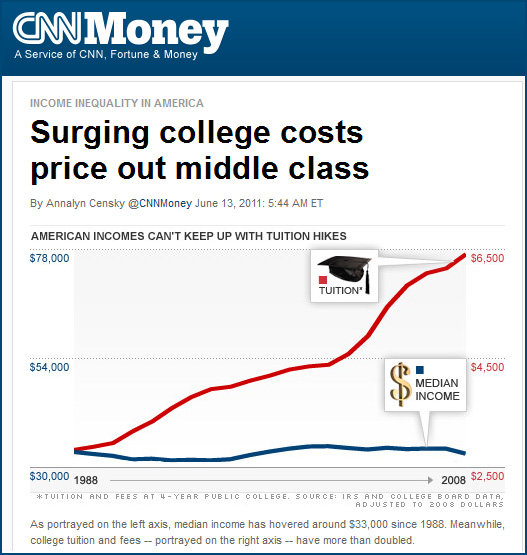
.
.
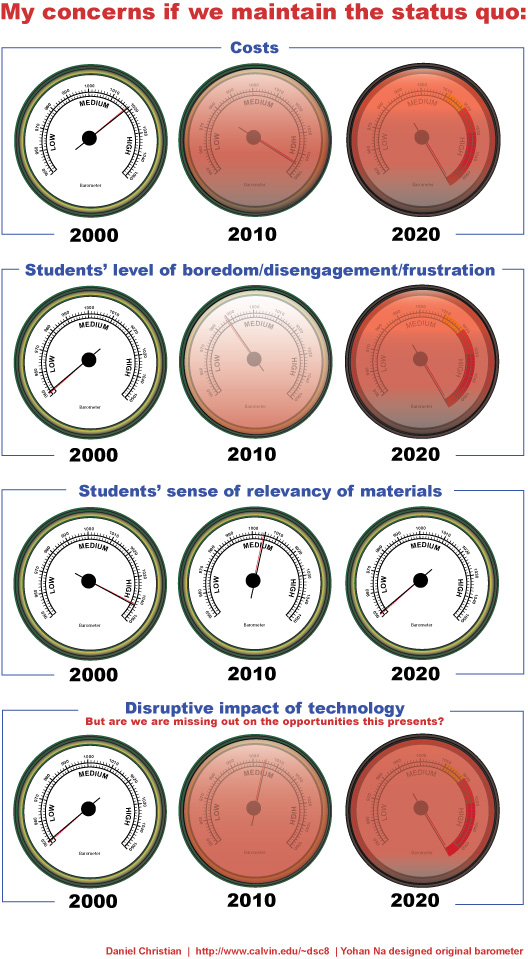
From 5/21/09
…and you can see that the Perfect Storm in Higher Ed has been amassed. Massive change is in the air. People will find a way to achieve their goals/objectives — one way or another. College is still a good call — but what “college” and “university life” will look like in 5 years will likely be very different from what they look like today.
There is no returning to the “good ol’ days” — things are not going back to the way they were 5-10 years ago. It’s time for massive — but controlled/intentional — experimentation within higher ed, to find out how best to use the Internet in order to promote learning (and, hopefully, to still make a living!).
.

Some examples that illustrate that change is in the air…and that the conversation continues to move outside traditional institutions of higher education (I mention these not to dog higher ed, but to get us to innovate, to reinvent ourselves, and to stay relevant!)
Big idea 2013: College becomes optional — from LinkedIn.com by Ben Smith
Jailbreaking the degree: The end of the 4 year diploma — from onlineuniversities.com by Justin Marquis
Excerpt:
What’s wrong with getting a college degree? According to the grassroots movement, “Jailbreaking the Degree,” being pushed by radical education startup Degreed.com, quite a bit. The organization has identified several fundamental flaws with the long standing college degree process. It aims to overcome them and dramatically change the nature of learning and credentialing in the process. In order to justify their initiative they present some dramatic numbers on their website…
Degreed wants to jailbreak the college degree — from techcrunch.com by Rip Empson
Saying no to college — NYT.com by Alex Williams
Do a Google search on uncollege.org and see what you get
The rise of college alternatives— from huffingtonpost.com by Dan Schawbel
educreations.com: Teach what you know. Learn what you don’t.
Addendum on 12/14/12:
From DSC:
We had better step up the pace of innovating/experimenting – and move to do so quickly. But the problem is, moving quickly is not in the cultures of most of the more traditional institutions of higher education.
Also relevant:
